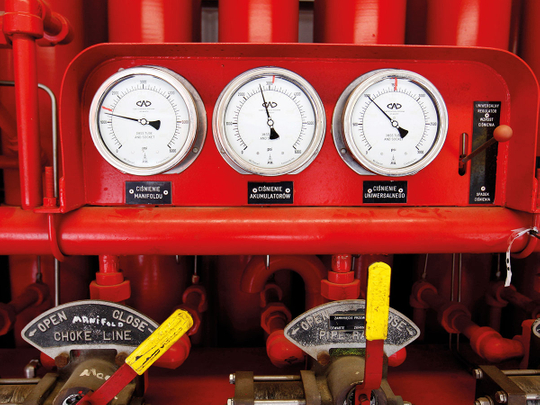
New York: US shale’s response to Opec’s decision to cut supply and boost prices: We’ll take it, but we don’t need it.
In 2014, the US oil industry’s fate seemed to rest in the hands of Opec ministers who were flooding the market with cheap oil in a push to obliterate them. Now, the cartel is in full retreat, agreeing to cut output to keep their own economies healthy even as US production continues to surge.
The move came in a week in which oil fell to near $50 (Dh183) a barrel, a price that four years ago would have panicked US drillers. But since then, shale explorers have cut costs, boosted fracking efficiency and made wells longer and more productive. The result: Break-evens for a 30 per cent profit have been almost halved to just $45 a barrel in the prolific Permian Basin.
“The shale industry can now thrive in a $50 oil world,” David Deckelbaum, a New York-based analyst at Cowen & Co., said by phone. The Opec decision to support prices over $50 in the US “underwrites most of the industry.”
US oil producers are now generating 11.7 million barrels of oil a day, about a third more than in 2014, with almost half the number of rigs. And last week, the industry became a net exporter for the first time in 75 years.
To be sure, the break-evens companies often cite don’t necessarily mean producers will be pumping big profits at $50-a-barrel oil. They exclude corporate expenses and land acquisition costs, which can be substantial. Still, they remain strongly indicative of the “drill or no drill decision,” said Ian Nieboer, an analyst at RS Energy Group who sees the US pumping an extra 1 million barrels a day in 2019.
“The full pace and capability of the US industry is not yet completely appreciated” by Opec and its allies, Nieboer said in an interview. “Everybody is still catching up to how efficient this industry has become.”
Oil producers in the US are “breathing a sigh of relief” as a result of the Opec agreement, said Saudi Arabia’s oil minister Khalid Al Falih said at a news conference in Vienna on Friday. Low oil prices are “not good for the US economy,” Al Falih said, adding that America now has “more at stake” alongside Saudi Arabia because US oil output has increased.
In 2014, wells drilled in the Permian, home to a third of US output and the world’s fastest-growing major oilfield, needed a price of $86.10 a barrel to turn a 30 per cent profit, according to Calgary-based RS Energy Group. Now that figure is $45 a barrel, giving producers incentive to drill at current prices. The story is similar story for the Eagle Ford in south Texas and the Bakken in North Dakota.
Opec and their allies, including Russia, met in Vienna on Thursday and Friday. The agreement they made was to remove 1.2 million barrels a day from the market, with Opec itself shouldering 800,000 barrels of the burden. Following the announcement, oil in New York jumped by as much as 5 per cent to $54.22 a barrel.
Oil at $50 is at the low end of what shale companies typically plan for, suggesting that they may trim 2019 capital budgets, which executives are currently planning. “There will still be growth but it will be more restrained,” said Irene Haas, a Houston-based analyst at Imperial Capital Group LLC “It’s not party time.”
Investors have been vociferous in their appeal for producers to only spend what they earn rather than take on debt or sell new shares. But so far, signs of austerity are mixed, with companies showing no signs of retreating from their core areas.
Chevron Corp. will hike spending on the Permian by 9 per cent, the company said in a statement Thursday, while Devon Energy Corp. also plans to spend more next year. That said, its capital expenditure range of $2.4 billion to $2.7 billion was below Bloomberg’s analyst estimate. Anadarko Petroleum Corp. plans to cut spending by about 3 per cent next year.
A pipeline bottleneck in the Permian will start to disappear next year with three major projects slated to open, potentially adding more than 2 million barrels a day of capacity. Coupled with higher oil prices, that could provide ample opportunity for companies to begin utilising the almost 3,900 wells that have been drilled in the Permian but not yet opened.
Oil prices in New York opened the year at around $60 a barrel, then climbed above $75 on October 1, before plunging to near $50 since then. That run of higher prices prompted producers to offer stock buy-backs and award dividends, financial moves that can serve as a ‘safety valve’ if prices continue to stay low, said Sajjad Alam, senior analyst at Moody’s Investor Service.
Yet the recent plunge in oil prices did catch management teams off guard. Only about 7 per cent of executive interviewed by the Dallas Federal Reserve in September anticipated West Texas Intermediate prices falling below $65 a barrel by the end of the year. Currently the US benchmark trades at about $53 a barrel.
Moody’s is much less concerned about debt levels now than four years ago.
“Companies have done a lot of work to bring their cost structure and capital structure to a position where they can live through a volatile and low price environment,” Alam said. “At 50 dollar oil, production is probably not going to slow down a whole lot.”












